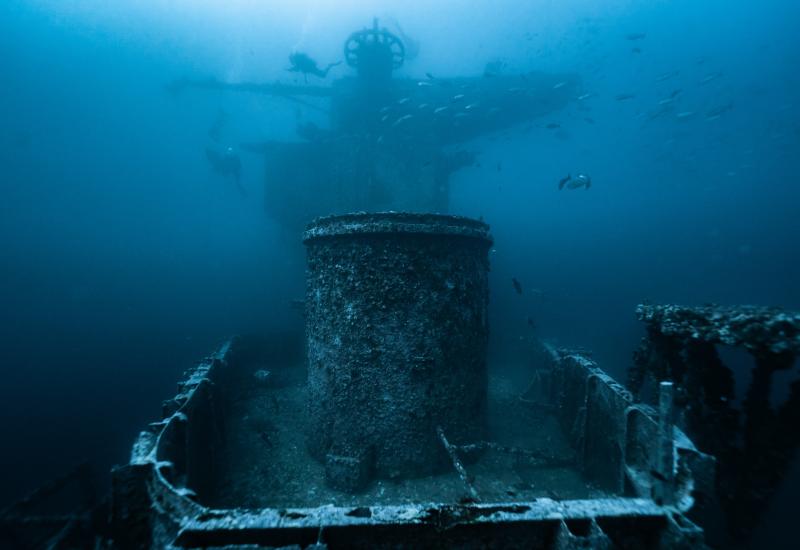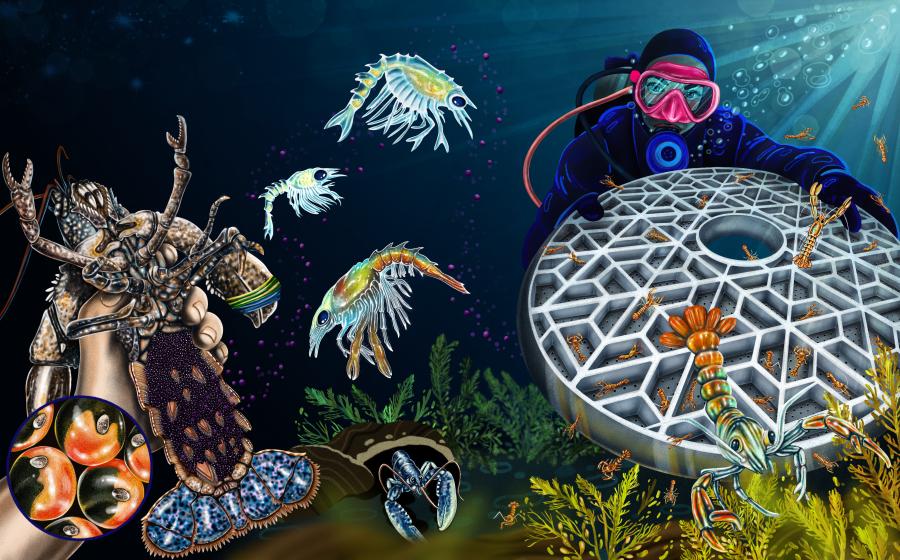Diving the Reefs and Wrecks of Greater Fort Lauderdale
Off Florida’s coast, reefs, wrecks, and currents both mild and wild offer thrilling drifts.

ShutterstockLobsters are reliable hide-and-seek partners all up and down the Florida coast.
^^I^^n South Florida, there are two seasons: summer, which lasts roughly 340 days, and winter-ish, which rounds out the remaining 25 days (and typically still sees average temperatures that some consider bikini weather). We Floridians are spoiled: We wear flip-flops year-round, are never more than an hour’s drive from the beach, and have some of the country’s best diving in our backyard. On the southeast Atlantic coast of the Florida Peninsula, Fort Lauderdale is known for its beaches, mega-yachts and network of canals, but take it from a local: To fully experience the laid-back Florida lifestyle and the best diving on the east coast, head to the slower-paced towns just north of Fort Lauderdale’s tourist-fueled buzz.
Our tour begins in Deerfield Beach, a quaint town with a lot to charm divers. We check in for a two-tank boat dive with Dixie Divers. We’ll be starting with a wreck dive before relocating for our second tank, a reef drift dive. This profile is the standard in the Greater Fort Lauderdale area, which is peppered with shipwrecks and bordered by a three-tiered natural-reef structure that offers easy drift diving year-round. Our wreck for the day: Copenhagen.

Sarosh JacobCopenhagen's massive anchor is a signature of the ship off Pompano Beach.
In 1900, just two years after Copenhagen was built, the 325-foot steamer was headed for Havana lugging 5,000 tons of coal and 26 crew members when it ran aground off Pompano Beach. The ship was intact, resting mostly submerged in 31 feet of water, until it was destroyed by the U.S. Navy during World War II to prevent German U-boats from hiding behind it. The wreckage is now strewn over a large swath of seafloor. We spot French and queen angelfish, brightly colored parrotfish and schools of striped grunts. Along with the coral-covered skeleton of the ship, patches of coral reefs are abuzz with fairy basslets, butterflyfish and damselfish. But the highlight of our trip is the fully intact anchor deployed when Copenhagen ran aground.
Florida locals commonly refer to drift diving on South Florida’s linear reef tract as “valet diving” because the warm Gulf Stream current creates perfect drift conditions and keeps divers parallel to shore. Divers make a lazy-river-paced dive along the reef until they’ve exhausted their bottom time and are picked up by the boat after surfacing.
The Florida Reef is one of the only coral reefs in the continental U.S., and it offers excellent diving just offshore from coastal towns in Greater Fort Lauderdale. The reef spans the southeast coast of Florida from Palm Beach to the Keys and is divided into three tiers. The first reef begins roughly 300 yards from shore, with dive sites in a beginner friendly 15 feet of water. The second reef is a bit farther out, and ranges in depth from 45 to 60 feet. You’ll head about a mile offshore to reach the third tier, where depths range from 80 to 100 feet. Most operators offer drift dives on the first or second reef — which can be mild or wild depending on the current.
DIVING THE HALL OF FAME
Heading south to Fort Lauderdale — the “Venice of America” long ago shed its spring-break-crazy ”Fort Liquordale” reputation — we’re ready for what awaits us offshore. And not very far offshore either.
“In case we hit an iceberg today and we start sinking, you can be patient and wait for the Coast Guard to come pick us up,” jokes our divemaster. “But if you don’t want to wait that long, just swim to shore to the nearest tiki bar. If you guys don’t know where the nearest tiki bar is, just follow us.”
The section of reef we’ve dropped down on is known as Hall of Fame, which ranges from 15 to 30 feet deep and is just a few kicks from shore. We are treated to a rainbow of life along the limestone ridge, including bright-orange gorgonians, yellow sponges, delicate purple sea fans, and countless tropical fish bustling this way and that, as well as schools of grunts and yellowtails.
Kicking slightly against the current, my dive buddy calls me over to point out a massive lobster hiding beneath an overhang; before we finish the dive, we see both green and spotted moray eels, pufferfish and shrimp. Back on the boat, a couple of divers tell us that nurse sharks are sleeping just past where we’d surfaced. It’s a smorgasbord of treats, and we’re as satiated as diners at a cruise-ship buffet.
PARKS AND WRECKS
In addition to wrecks like Copenhagen, more than 110 artificial reefs have been purpose-sunk off Greater Fort Lauderdale since 1982. In the ’90s, the Peter B. McAllister and its sister ship, the Donal G. McAllister, were deliberately scuttled as part of Broward County’s artificial reef program. Diving the McAllister, a fair amount of current is running. But as soon as we reach the bottom, the ship provides shelter, along with a glittering first impression thanks to a school of blue-striped grunts. My buddy and I hover above the sand at roughly 65 feet, and I take in the array of colors: The 85-foot tug boat is decorated in a thick carpet of colorful corals and sponges, and is buzzing with marine life, including blue tangs, jacks, parrotfish and a variety of angelfish. There are a number of swim-throughs accessible by wreck certified divers only, but the wide opening in the McAllister’s hull is too good to resist. There we find a lush reefscape where bicolored damsels flit about.

Kevin HansonLady Luck
Pompano Beach, where we dived Copenhagen, is an ever-expanding playground for wreck divers to explore. The latest addition (and the centerpiece of Shipwreck Park) is the Lady Luck, which was purpose-sunk in July 2016 on the outskirts of Florida’s third reef line at depths between 70 and 120 feet.
In collaboration with the Isle Casino Racing Pompano Park, Pompano Beach transformed this 324-foot tanker into an underwater art display and “casino” — fully equipped with an eight legged octopus dealing poker. The ship rests upright just 1 mile offshore of Pompano Beach, and features rotating art exhibits for divers to explore.

Lureen FerrettiLady Luck has lots of fun surprises for divers.
“The swim-throughs are open so you can experience the inside of the wreck,” says Agustina Prigoshin, a local diver who was among the first on the Lady Luck after it was sunk. “I was aboard the ship the day before it sank, so it was neat to see her underwater soon after. There was no life on it! It felt eerie, abandoned, but there was a strong current that day, so it was pretty fun to be able to grab onto the ship and pull yourself along it without damaging any coral.”
Now the Lady Luck is blossoming with corals and marine life. “Coral is growing all over, and tons of fish now call her home: spadefish, goliath grouper, jacks, big barracuda — and we now have a resident bull shark that hangs around,” says Prigoshin. Like I said: Floridians are spoiled.
Itinerary Greater Fort Lauderdale
DAY ONE
After exploring Deerfield Beach’s underwater offerings with Dixie Divers, head over to the Sticky Bun. The locally owned cafe serves breakfast and lunch all day, and all of its food is cooked to order. Try the six-slice BLT (with bacon that’s cooked to perfection) or the Sticky Bun Classic spread of eggs, bacon, toast and fresh fruit. But whatever you do, don’t leave without a sticky bun (even if it’s to-go). After you’ve gotten your fill, make the 6-mile drive south to Pompano Beach, and check in at the locally owned Bahama Beach Club cottages to unload your gear and hang by the pool.
DAY TWO
Enjoy a waterside view and incredible seafood at the Rusty Hook Tavern, conveniently located next to South Florida Diving Headquarters. Your server will give you the rundown on the specials and catch of the day (always a good bet), but be sure to start off with the ahi tuna nachos. The crispy chips are packed full of tuna, kimchi, cilantro and avocado, and it’s more than enough to share (but you might not want to).

ShutterstockJungle Queen Riverboat Dinner Cruise and Show
DAY THREE
Whether you want lunch after your dives with Sea Experience or dinner and great drinks, look no further than Briny Irish Pub. This local dive bar has some of the friendliest bartenders you’ll meet in Florida, and the Reubens, fries and burgers are all to die for. If you have time before you head back home, plan an airboat tour of the Florida Everglades or have dinner on the water as you tour Fort Lauderdale’s New River on Jungle Queen Riverboat Dinner Cruise and Show.
NEED TO KNOW
WHEN TO GO South Florida offers great diving year-round; water temperatures range from the low 70s in winter to the mid-80s in summer. For the best conditions above and below the surface, plan your trip from May through September.
DIVE CONDITIONS The southeast coast of Florida receives a steady current from the Gulf Stream, which makes for easy rides when conditions are mild — and thrilling drifts when the current kicks it up a notch. Visibility varies from 40 to 100 feet, depending on the current; most divers wear a 3 or 5 mm wetsuit year-round.

Courtesy Bahama Beach ClubBahama Beach Club
OPERATORS Dixie Divers in Deerfield Beach; South Florida Diving Headquarters in Pompano Beach; Sea Experience in Fort Lauderdale.
PRICE TAG All of these South Florida dive operators offer two-tank dives starting at $60, and off er gear-rental packages as well as air and nitrox tank rentals on-site.
WHERE TO STAY Bahama Beach Club, Pompano Beach, 4rentbythebeach.com









